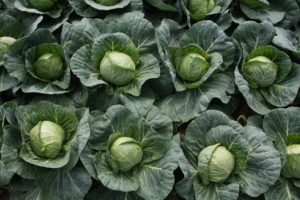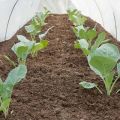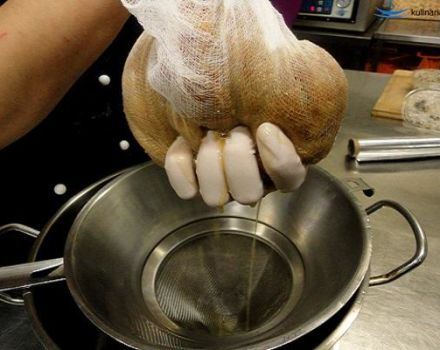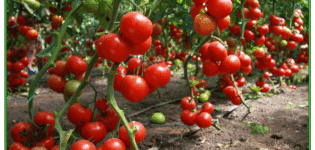Growing and caring for Brussels sprouts in the open field
Today, in modern summer cottages, you can find a huge number of different vegetables. Some are engaged in growing cucumbers with tomatoes, while others are attracted by Brussels sprouts, the cultivation and care of which requires certain skills and abilities from the grower. Therefore, before growing Brussels sprouts, it is necessary to study the peculiarities of growing Brussels sprouts.
Sowing seedlings
To grow Brussels sprouts in the open field, you need to decide on the timing of its planting. Seedlings of Brussels sprouts Cassio, should be grown from early April until the end of the following month. This time will be enough to get quality seedlings. In Siberia, planting is recommended a few months later.
Seed preparation
Brussels sprouts Hercules, Rosella and many other varieties must be prepared for planting. To begin with, you should start calibrating the planting material in order to immediately get rid of defective seeds. To do this, a saline solution is poured into a small container. Then the seeds are placed in it and soaked in liquid for about 5-10 minutes. During this time, all the bad seeds will float to the surface, and the good ones will remain below.
Having got rid of the defective seeds, all the remaining ones need to be checked for germination. A soaked cloth is placed in a small plate, on top of which all the seeds are laid out. They are covered with a cloth and soaked for three days. The best quality planting material should swell well during this time.

It is recommended to plant Brussels sprouts in open ground, the seeds of which have been subject to disinfection in advance. This procedure is needed to rid all seeds of possible pathogens of fungal or bacterial diseases. Many vegetable growers use a manganese solution for this. The procedure is carried out in stages and in a certain sequence. First, a weak solution of manganese is poured into a small container, after which seeds are placed in it for half an hour. Then all the cabbage seeds are removed, washed and dried.
Also, before planting cabbage, it is necessary to accelerate the germination of its seeds. To do this, they should be soaked in warm water for about 10 hours. In this case, it is recommended to change the liquid every 3 hours so that it does not have time to completely cool down.

Soil preparation
The planted seed must be grown in neutral or fertile soils. In all other soils, seedlings grow much worse.Also, to improve the yield and growth of the plant, you can use pre-prepared land, which can be purchased in almost all suburban shops.
Cabbage does not tolerate soils with a small amount of mineral elements, and therefore, in order to set up many heads of cabbage in the future, you will have to fertilize the soil yourself. It is recommended to prepare a soil mixture, which will consist of an equal amount of sand, turf and peat. You can also add some humus and compost to the soil. However, in this case, one should be very careful, since these components have a beneficial effect on the development of the black leg.
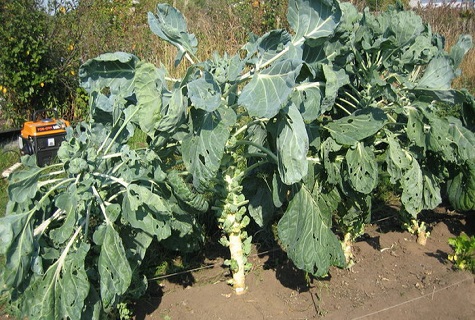
Sowing
The agricultural technology for planting seeds is quite simple. It must be planted in small containers, no more than 5-7 cm deep. In each of the containers, you must add the soil mixture that was prepared earlier. After that, the whole earth is watered with manganese potassium solution and infused for 5-10 minutes.
Then they begin to make holes for planting seeds. Their depth should be about 1 cm, and their width should be 2-3 cm. When all the seeds are planted, the holes are sprinkled with a small layer of earth and watered with heated water. Then all containers are covered with plastic wrap and transferred to a bright room. They are opened only after the first shoots appear.
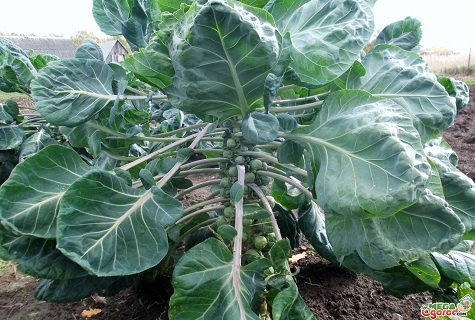
Planting seedlings
Outdoor cultivation of Brussels sprouts should be carried out in the second half of spring, when the outside temperature will always be above freezing.
Site selection
Grow Brussels sprouts only in areas that are ideal for it. For early varieties such as Casio, sandy loam or light loamy soil is suitable. Such soils are freed from snow earlier than others and warm up very quickly.
Late and mid-season Brussels sprouts grow best on heavy loamy soil or meadow soil. It is not recommended to plant them in a garden with soil that has an increased acidity level. Quite often, due to too acidic soil, heads of cabbage are not tied.
Brussels sprouts must have suitable predecessors. It is recommended to plant it in areas where carrots, cucumbers, onions, legumes or perennial herbs were previously grown. If cruciferous vegetables were previously grown in the chosen place, then this can lead to the fact that the fruits will not set well.
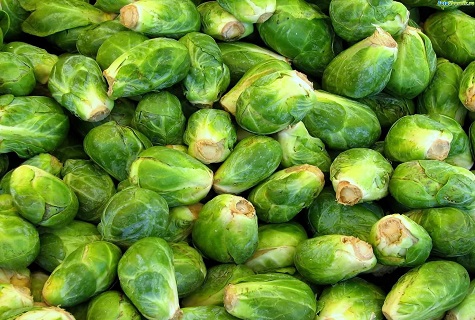
Site preparation
In the Moscow region and other nearby regions, it is necessary to prepare a site in the country in the autumn. During this period, the soil is fertilized and dug up. The site is fertilized with manure and other organic matter, after which the whole land is harrowed and dug up. You should also be sure to level the site so that there are no strong depressions and pits on it.
It is imperative to clear the area from the remains of other plants and weeds, since they are one of the main carriers of various diseases.
The next stage of site preparation is carried out in early spring. At this time, you need to do soil fertilization. A compost bucket with humus is added to the soil. Also, a little wood ash with superphosphate and urea is added to the open ground.
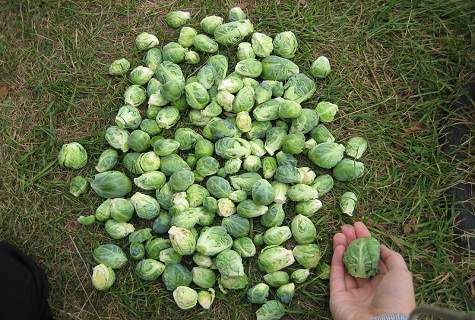
Planting
To understand how to properly plant cabbage at home, you need to familiarize yourself with the main features of this process. Planting is necessary only in the evening or on cloudy days, so that there is no bright sunlight. The fact is that immature seedlings, the first few hours after transplanting, should not be in the sun.
First you need to do the marking of the beds. The distance between each bed should be about 50-70 cm so that the bushes do not interfere with each other. After marking them, you need to start creating holes. They should not be very large, as the seedlings have a small root system.A little organic fertilizer should be added to each hole and mixed with the soil. Then seedlings are placed in them and sprinkled with soil.
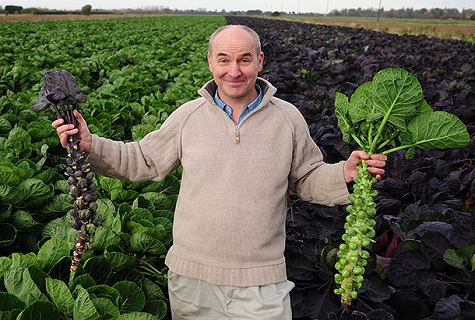
Care features
In order for large heads of cabbage to be tied on the bushes, you need to properly care for the plant from sowing to harvest. After all, it is the planting and care that affects the quality of the fruits obtained.
Watering
Caring for Brussels sprouts must necessarily include regular watering of young seedlings. In order for the bushes to grow well, they need to be watered every 3-4 days within two weeks after planting. At the same time, at least eight liters of liquid should be consumed per square meter. Very frequent watering can affect the appearance of new lower leaves. If there are too many of them, you will have to periodically pick off the leaves.
Watering can be increased only in early June, when most of the fruits are tied. The procedure will have to be carried out several times a day - in the evening and sutra. In this case, it is necessary to use water heated to room temperature.
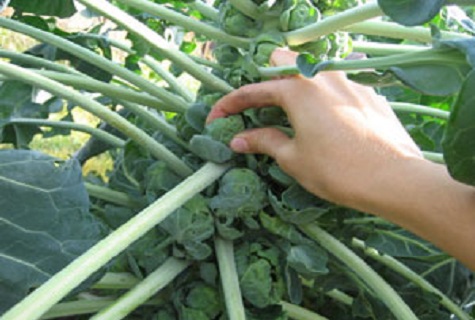
Loosening
During the cultivation and care of Brussels sprouts, it is imperative to loosen the soil, as growing cabbage needs it. Especially after heavy rains have passed. The procedure is performed regularly 2-3 times every few weeks. To get rid of the crust on the ground, you do not need to loosen it too deep. It will be enough to loosen the ground to a depth of about 5-7 cm.
The first hilling is carried out one month after planting the seedlings in the garden. The second time, the procedure is carried out after eight days. Due to hilling, additional roots on the side may appear on the bushes. To prevent them from appearing, during loosening, you should retreat 5-10 cm from the base of the plant.
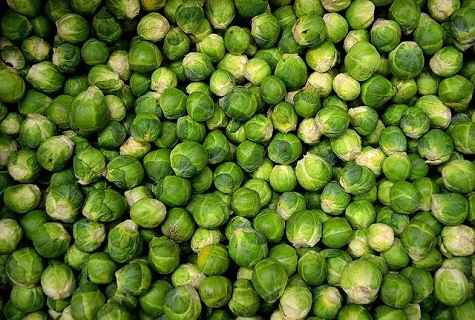
Top dressing
It is necessary to feed the soil regularly when growing cabbage. For the first time, fertilizers are applied to the ground two and a half weeks after the seedlings are planted. During this period, organic fertilizers diluted in water are used. The second time, the procedure is repeated after 10-15 days. In this case, bird droppings with mullein and superphosphate are added to the ground.
Harvesting
Harvesting should be three and a half months after planting seedlings on the site. After such a period of time, all the heads of cabbage that have tied up look fully ripe. First you need to remove the heads of cabbage, which are located at the bottom of the bushes. Then you can cut off the fruits that are higher. It is very important to have time to harvest before the first frost. Indeed, at low temperatures, heads of cabbage begin to deteriorate quickly. All collected heads of cabbage must be cut off. The rosette and the upper bud are removed from them. This is done in order to keep the harvest longer.
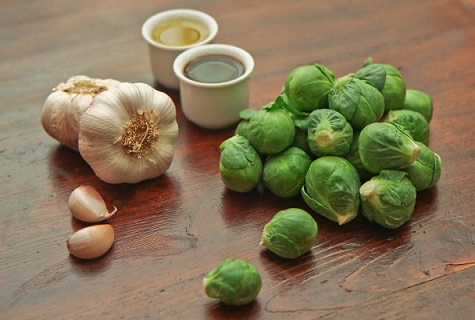
Conclusion
Get a good harvest of cabbage not that difficult. To do this, you need to watch photos and videos of growing and caring for Brussels sprouts in the open field.

